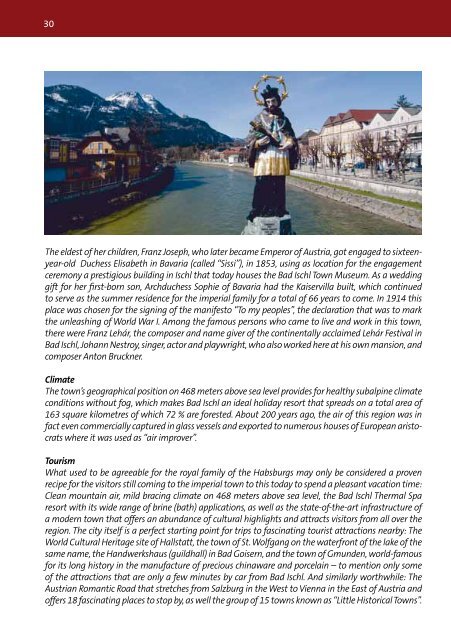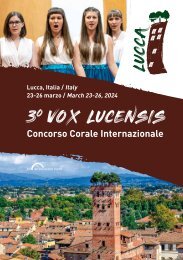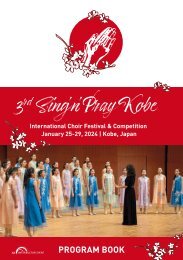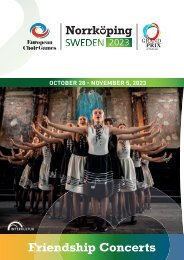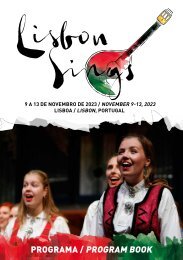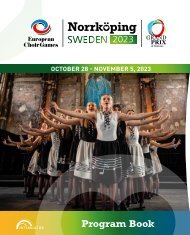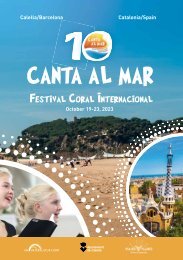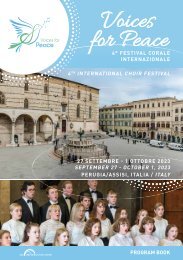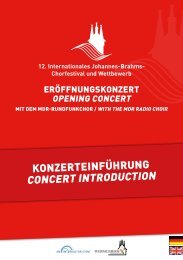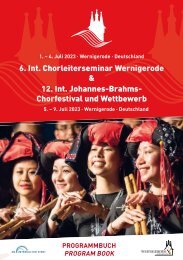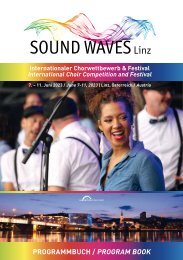Program Book - Bad Ischl 2014
The Program Book of the International Choir Competition & Festival Bad Ischl, Austria from April 30 to May 4, 2014.
The Program Book of the International Choir Competition & Festival Bad Ischl, Austria
from April 30 to May 4, 2014.
You also want an ePaper? Increase the reach of your titles
YUMPU automatically turns print PDFs into web optimized ePapers that Google loves.
30<br />
The eldest of her children, Franz Joseph, who later became Emperor of Austria, got engaged to sixteenyear-old<br />
Duchess Elisabeth in Bavaria (called “Sissi”), in 1853, using as location for the engagement<br />
ceremony a prestigious building in <strong>Ischl</strong> that today houses the <strong>Bad</strong> <strong>Ischl</strong> Town Museum. As a wedding<br />
gift for her first-born son, Archduchess Sophie of Bavaria had the Kaiservilla built, which continued<br />
to serve as the summer residence for the imperial family for a total of 66 years to come. In 1914 this<br />
place was chosen for the signing of the manifesto “To my peoples”, the declaration that was to mark<br />
the unleashing of World War I. Among the famous persons who came to live and work in this town,<br />
there were Franz Lehár, the composer and name giver of the continentally acclaimed Lehár Festival in<br />
<strong>Bad</strong> <strong>Ischl</strong>, Johann Nestroy, singer, actor and playwright, who also worked here at his own mansion, and<br />
composer Anton Bruckner.<br />
Climate<br />
The town’s geographical position on 468 meters above sea level provides for healthy subalpine climate<br />
conditions without fog, which makes <strong>Bad</strong> <strong>Ischl</strong> an ideal holiday resort that spreads on a total area of<br />
163 square kilometres of which 72 % are forested. About 200 years ago, the air of this region was in<br />
fact even commercially captured in glass vessels and exported to numerous houses of European aristocrats<br />
where it was used as “air improver”.<br />
Tourism<br />
What used to be agreeable for the royal family of the Habsburgs may only be considered a proven<br />
recipe for the visitors still coming to the imperial town to this today to spend a pleasant vacation time:<br />
Clean mountain air, mild bracing climate on 468 meters above sea level, the <strong>Bad</strong> <strong>Ischl</strong> Thermal Spa<br />
resort with its wide range of brine (bath) applications, as well as the state-of-the-art infrastructure of<br />
a modern town that offers an abundance of cultural highlights and attracts visitors from all over the<br />
region. The city itself is a perfect starting point for trips to fascinating tourist attractions nearby: The<br />
World Cultural Heritage site of Hallstatt, the town of St. Wolfgang on the waterfront of the lake of the<br />
same name, the Handwerkshaus (guildhall) in <strong>Bad</strong> Goisern, and the town of Gmunden, world-famous<br />
for its long history in the manufacture of precious chinaware and porcelain – to mention only some<br />
of the attractions that are only a few minutes by car from <strong>Bad</strong> <strong>Ischl</strong>. And similarly worthwhile: The<br />
Austrian Romantic Road that stretches from Salzburg in the West to Vienna in the East of Austria and<br />
offers 18 fascinating places to stop by, as well the group of 15 towns known as “Little Historical Towns”.


